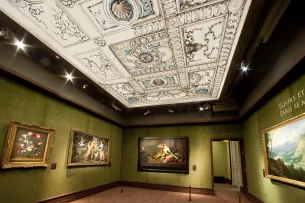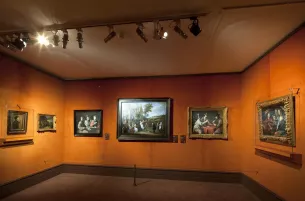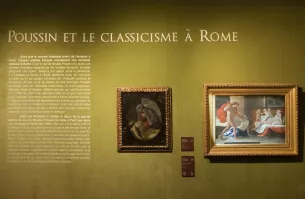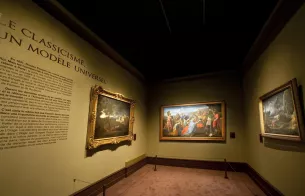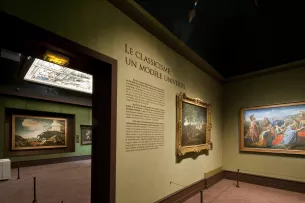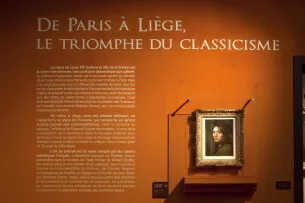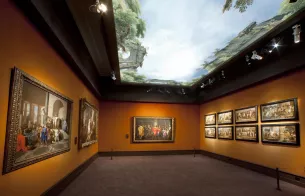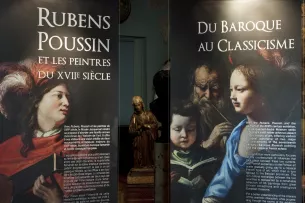ONLINE BOOKING STRONGLY RECOMMENDED. Due to the high number of visitors to the exhibition, access cannot be guaranteed for visitors without tickets.
EXHIBITION
Rubens, Poussin
and the 17th century artists
An exhibition of discovery
The exhibition’s primary aim is to highlight the importance of the Flemish movement in France at the beginning of the 17th century by showing the works of the great artists who were present on the French artistic scene at the time (Rubens, Pourbus, van Thulden, etc.). A comparison of their paintings with those of the Le Nain brothers or Lubin Baugin reveals the strong influence of the Flemish Baroque school on French artists.
The rest of the exhibition is devoted to the rise of French Classical art during the second half of the 17th century. It presents some new pictorial models, developed in France by Nicolas Poussin, Laurent de La Hyre, Eustache Le Sueur and Charles Le Brun, before being adopted by Flemish artists such as Bertholet Flemalle and Gérard de Lairesse. This is the note on which the exhibition finishes, thereby highlighting the reversal of influence which operated between these two schools during the 17th century.
The imprint of Rubens in Paris and the spread of flemish painting in France
The grand master of the Baroque, Pierre-Paul Rubens, arrived in Paris in 1625 with his series of canvases depicting the life of Mary of Medicis, Queen of France and widow of Henri IV. Commissioned four years earlier by the Queen, this imposing series of 24 pieces was destined to decorate the west wing of the Luxembourg palace in Paris. Today it hangs in the Louvre. At the start of the 17th century, 70% of Antwerp’s artistic production was exported, a large portion of it to France. In Paris, Saint-Germain des Prés village fair, hosted by Nordic merchants, sold a great many Flemish works of art. As a result, French artists and their sponsors came into contact with the Flemish style and acquired a taste for it.
Flemish dominance of the french artistic scene
Under the reign of Henri IV, and then the regency of Mary of Medicis, Flemish painters, with Pierre-Paul Rubens foremost among them, obtained the lion’s share of royal commissions, including Philippe de Champaigne for portraits and Frans Snyders for animal art.
This strong presence in France motivated French artists like the Le Nain brothers to adopt Flemish subjects and models in the field of genre painting.
The rise of French Classicism
The heyday of an artistic style from Flanders was succeeded by an “ideal” style of art started by Nicolas Poussin which exerted a poetic power that extended well beyond France’s borders.
In fact, during the reign of Louis XIII, a truly French pictorial identity was forged, appearing simultaneously in the work of artists like Nicolas Poussin, who remained profoundly marked by his time in Rome, and other artists who never left Paris, such as Eustache Le Sueur and Laurent de La Hyre. They all developed a new pictorial language: French Classicism.
French painting, a new point of reference from Liege to Amsterdam
Little by little, France built its own cultural identity which would influence many artists, in particular the Flemish. Attracted by the enormous potential of the French market and the magnificence of the court of Louis XIII and his successor Louis XIV, artists from the principality of Liège including Bertholet Flémal and Gérard de Lairesse came to Paris to perfect and learn French pictorial techniques.
The team
Curatorship
Nicolas Sainte Fare Garnot, an art historian specialising in seventeenth-century French painting, has been curator at the Jacquemart-André Museum since 1993. Since his appointment, he has reorganised the distribution of the collections according to the original programme and has initiated various restoration and inventory campaigns. Together with Culturespaces he has helped to create a new dynamic within the Museum by bringing his scientific approach to bear on temporary exhibitions whose subjects offer an opportunity to get to know the artists contained in the permanent collections.
Jan de Maere, an art historian and journalist, is director of the Documentation Centre for Flemish Heritage. He obtained his doctorate from the University of Geneva, under the supervision of Professor Mauro Natale, on the subject of “Connoisseurship and the Neurosciences”. He is the author of The Illustrated Dictionary of 17th Century Flemish Painters (La Renaissance du Livre, 1994) and L’Art flamand en Transylvanie (Openbaar Kunstbezit, 2007). Since 1980 he has worked as an expert specialising in Flemish art of the 16th and 17th centuries and Belgian modern art from 1830 to 1950, for which he occupies the following positions: member of the Chamber of Experts, responsible for legal affairs and arbitration; Honorary President of the Flemish Association of Experts in Works of Art (VVEKA); expert adviser to the courts and the police force; member of the Belgian Chamber of Experts in Works of Art; Director of the Documentation Centre for Flemish Heritage.
Scenography
Hubert Le Gall, born in 1961, is a French designer, creator and sculptor of contemporary art. His work has formed the subject of numerous exhibitions throughout Europe. Since 2000 he has produced original scenographies for exhibitions.

